During the Japanese occupation of the Philippines from 1942 to 1945, the cultural landscape underwent significant transformation. Artistic expressions, deeply rooted in Filipino identity, faced strict censorship and control. This period marked a unique chapter in the history of the nation’s creative endeavors.
Under Japanese rule, media and artistic works were closely monitored. Publications like the Tribune and Liwayway were allowed to operate but under strict surveillance. The occupiers aimed to use art as a tool to promote their agenda, often overshadowing the hardships of war.
Despite these constraints, Filipino artists found ways to adapt and resist. Their works reflected resilience and a silent rebellion against oppression. This era highlights how external forces shaped the structure of creative expression, leaving a lasting impact on the cultural evolution of the Philippines.
Key Takeaways
- Japanese censorship during 1942-1945 significantly influenced Filipino art.
- Media outlets like the Tribune operated under strict surveillance.
- Art became a tool for both propaganda and silent resistance.
- Filipino artists adapted their works to reflect resilience and identity.
- This period shaped the cultural evolution of the Philippines.
Introduction to the Glossary on Filipino Art Under Japanese Censorship
Filipino artists navigated a complex landscape of censorship during the Japanese occupation. This glossary aims to clarify key terms and concepts that defined creative expression during this period. By understanding these terms, readers can better appreciate the resilience and adaptability of Filipino creators.
Purpose and Scope
The glossary serves as a guide to the language and ideas that shaped Filipino art under Japanese rule. It covers both visual and performing arts, highlighting how artists used their work to reflect identity and resist oppression. The scope includes definitions of roles, techniques, and materials that were central to creative work during this time.
As one historian noted,
“Censorship forced artists to find new ways to communicate, often embedding deeper meanings in their work.”
This glossary helps uncover those hidden layers.
Overview of Key Terms
To understand the impact of Japanese censorship, it’s essential to explore key terms. These include the roles of the artist, the significance of creative work, and the materials used in painting and other forms of expression. Below is a table summarizing some of these terms:
| Term | Definition |
|---|---|
| Artist | A person who creates visual or performing works, often under constraints. |
| Painting | A visual work created using pigments on a surface, often reflecting cultural themes. |
| Work | Any creative output, from paintings to performances, that conveys meaning. |
| Term | A word or phrase used to describe a specific concept in art. |
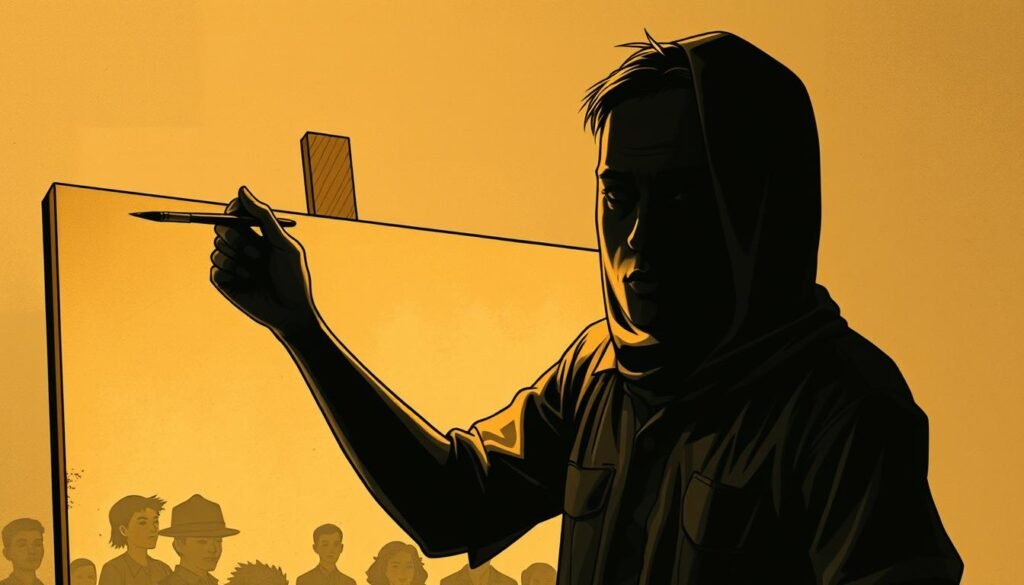
This glossary invites readers to explore the nuanced definitions that shaped Filipino art during a challenging era. By understanding these terms, we gain insight into how artists adapted their work to reflect resilience and identity.
Historical Context of Filipino Art
The roots of Filipino creative expression stretch back centuries, shaped by diverse cultural influences. From pre-colonial times to the colonial era, the Philippines has been a melting pot of traditions and innovations. This rich history laid the foundation for the unique artistic identity seen today.
Pre-colonial and Colonial Influences
Before the Spanish arrived in the 16th century, Filipino creativity was already thriving. Indigenous communities created intricate sculpture and functional objects that reflected their daily lives and spiritual beliefs. The Butuan boats, dating back to 689 AD, showcase early craftsmanship in maritime transport.
During the Spanish colonial period, religious themes dominated. Churches and religious objects became central to creative work. This era also introduced European techniques, blending with local traditions to create a unique style.
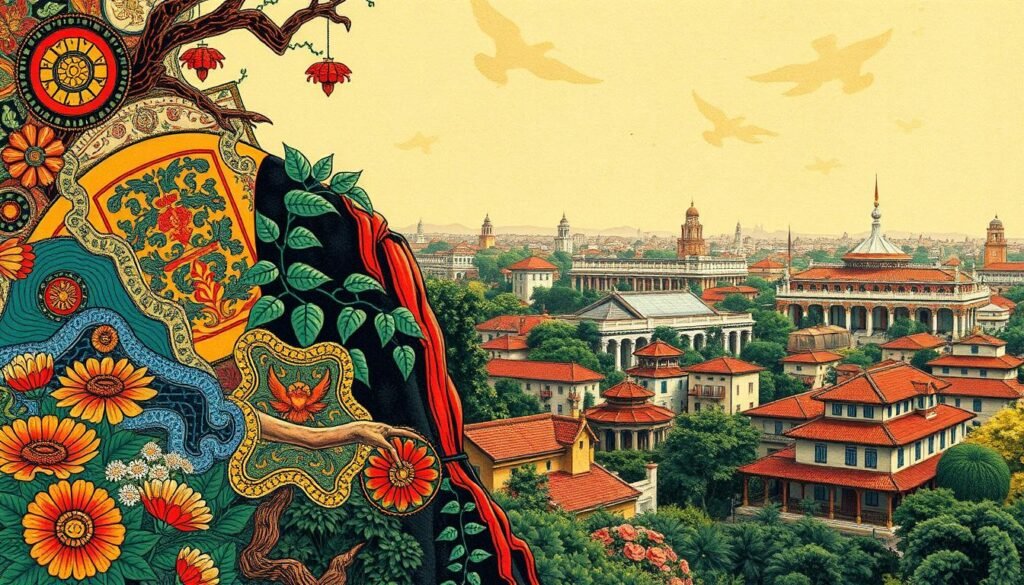
Impact of Asian Cultural Exchange
Asian cultural exchange played a significant role in shaping Filipino creativity. The introduction of Islam in the 13th century brought new forms of architecture and design. The Angono Petroglyphs, believed to be the oldest known works, highlight early artistic expression.
Notable artists like Victorio Edades and Carlos “Botong” Francisco emerged in the 20th century, blending traditional and modern techniques. Their works reflect the resilience and adaptability of Filipino creators.
“The history of Filipino creativity is a testament to the nation’s ability to adapt and innovate.”
From pre-colonial objects to modern masterpieces, the evolution of Filipino creativity is a story of resilience and cultural fusion. This historical context provides a deeper understanding of the nation’s artistic heritage.
Japanese Censorship Policies in the Philippines
The Japanese occupation of the Philippines introduced strict censorship policies that reshaped creative expression. From 1942 to 1945, the Japanese military enforced rigorous controls on all forms of media and cultural output. These measures aimed to suppress dissent and promote their ideological agenda.
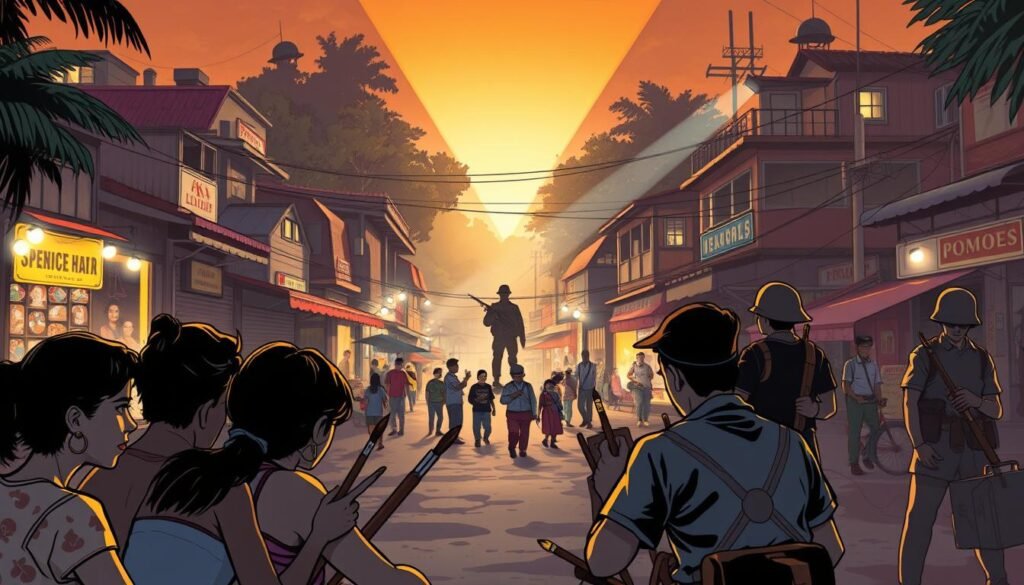
Governmental Guidelines and Restrictions
Japanese authorities implemented detailed guidelines to regulate creative works. The Film Law of 1939, for example, mandated the “healthy development of the industry,” banning films with social issues or frivolous themes. This law extended to the Philippines, where it influenced local productions.
Artists faced significant challenges in navigating these restrictions. The concept of subject in artworks was tightly controlled. Works deemed critical of the occupation or supportive of Filipino identity were often censored or banned. This led to a shift in creative strategies, with many artists embedding hidden messages in their works.
Figures like Marcel Duchamp, known for challenging traditional norms, became symbolic of artistic defiance. While Duchamp himself was not directly involved, his influence inspired Filipino creators to explore unconventional methods of expression.
During the 20th century, these policies shaped the cultural landscape. Societal expectations and prescribed content dictated the narrative of creative works. This period highlights the tension between artistic freedom and governmental control.
| Policy | Impact |
|---|---|
| Film Law of 1939 | Restricted themes in films, promoting propaganda. |
| Regulation of Subject | Limited artistic freedom, forcing hidden meanings. |
| Societal Expectations | Shaped content to align with Japanese ideology. |
These censorship policies not only affected visual and performing arts but also influenced the broader society. They left a lasting impact on the cultural evolution of the Philippines, demonstrating the resilience of its creators in the face of adversity.
Art and Expression Under Suppression
Under Japanese rule, Filipino creators faced immense challenges in expressing their cultural identity. Strict censorship policies forced artists to rethink their strategies, leading to innovative adaptations in both visual and performing arts. Despite the oppressive environment, their work became a testament to resilience and silent resistance.
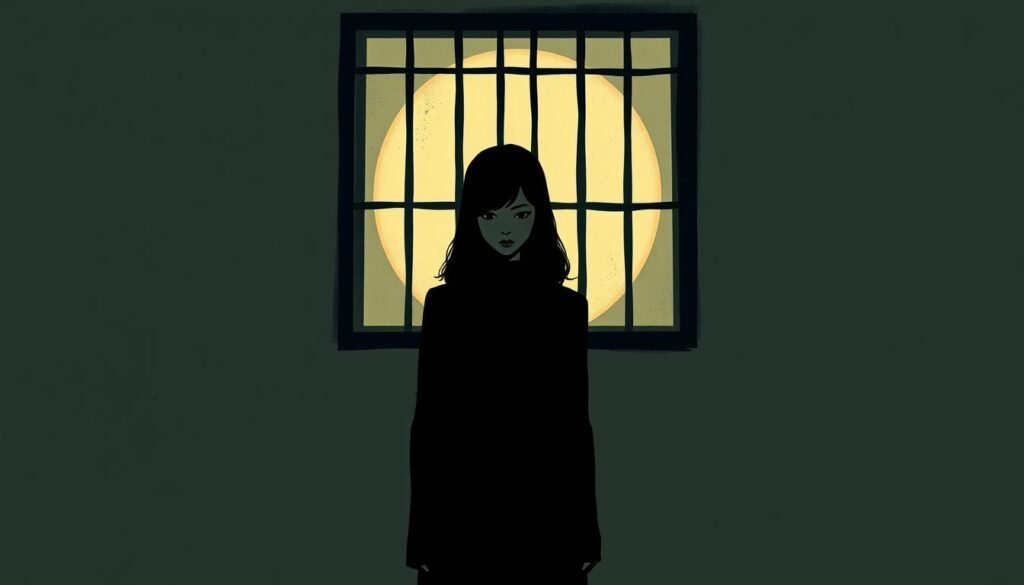
Adaptation of Visual Arts
Filipino visual artists ingeniously modified traditional techniques to convey subtle messages. Paintings and sculptures often incorporated symbolic elements that evaded censorship. For example, landscapes and everyday objects were used to reflect the struggles of the time.
One notable approach was the use of layered meanings. Artists embedded deeper narratives within their work, allowing viewers to interpret hidden messages. This technique ensured that their expression remained intact, even under scrutiny.
Transformation in Performing Arts
Performing arts also underwent significant changes during this period. Theater groups and musicians adapted their performances to align with censorship guidelines while still conveying powerful messages. Traditional dances and music were infused with new themes of resilience and hope.
For instance, folk songs were rewritten to include coded lyrics that spoke of resistance. These performances became a form of silent rebellion, uniting communities and preserving cultural identity.
“Censorship forced us to be more creative. Every brushstroke, every note, carried a hidden story.”
Despite the restrictions, Filipino artists maintained a dynamic creative spirit. Their ability to adapt and innovate under such conditions highlights the enduring power of artistic expression. This period not only shaped the evolution of Filipino art but also reinforced its role as a tool for cultural preservation and resistance.
Glossary of Key Terms in Artistic Expression
Understanding the terminology of artistic expression is essential to grasp the nuances of Filipino creativity during the Japanese occupation. This glossary provides clear definitions of key terms, helping readers appreciate the resilience and adaptability of Filipino creators under censorship.
Defining Artistic Work and Medium
In the context of creative media, a work refers to any output that conveys meaning, whether it’s a painting, sculpture, or performance. During the occupation, Filipino artists often embedded hidden messages in their works to evade censorship.
The form of a work refers to its physical structure or medium. For example, paintings used pigments on surfaces, while sculptures employed materials like wood or bronze. These forms were adapted to reflect cultural themes and resistance.
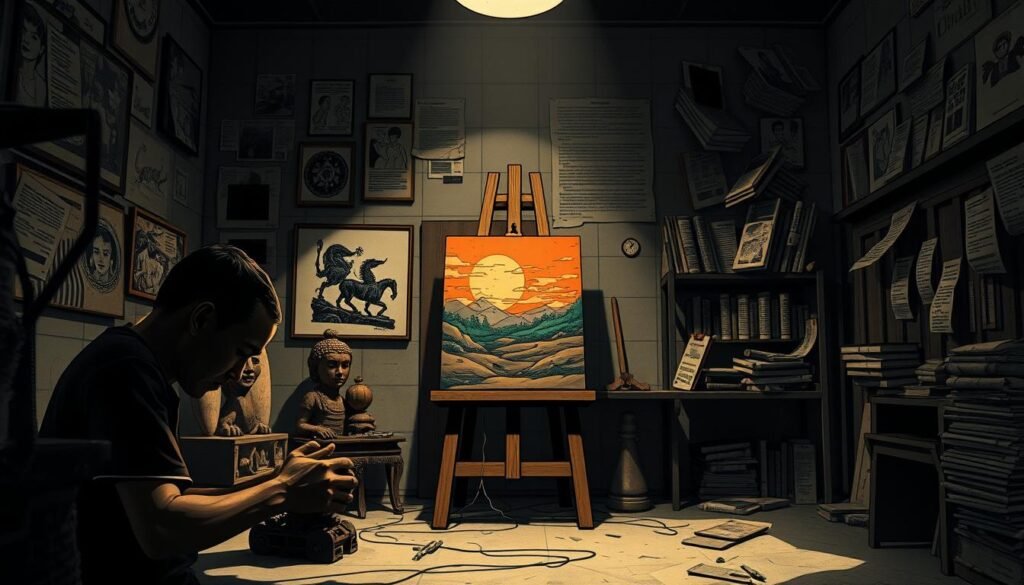
Content describes the subject matter or message within a work. Under Japanese rule, artists had to carefully choose content to avoid censorship while still expressing their identity. This led to the use of symbolic elements and layered meanings.
An image is a visual representation within a work. Filipino artists often used everyday objects or landscapes to subtly convey deeper narratives. This technique allowed them to communicate without direct confrontation.
The term art history refers to the study of artistic movements and their evolution. Understanding this helps contextualize how Filipino creators adapted their works during challenging times. For instance, techniques like Chiaroscuro and styles like Impressionism influenced their approach.
| Term | Definition |
|---|---|
| Work | Any creative output, from paintings to performances, that conveys meaning. |
| Form | The physical structure or medium of a creative work. |
| Content | The subject matter or message within a work. |
| Image | A visual representation within a work, often symbolic. |
| Term | A word or phrase used to describe a specific concept in art. |
This glossary serves as a reference point for understanding the techniques and innovations in Filipino art. For more on the historical context, explore the legacy of William Cameron Forbes in the Philippines.
The Role of Art in Cultural Identity
Cultural identity finds its strongest voice through the creative expressions of a community. In the Philippines, artistic practices have long served as a bridge between the past and the present, shaping a collective sense of belonging. From traditional crafts to modern paintings, art reflects the values, struggles, and aspirations of its people.
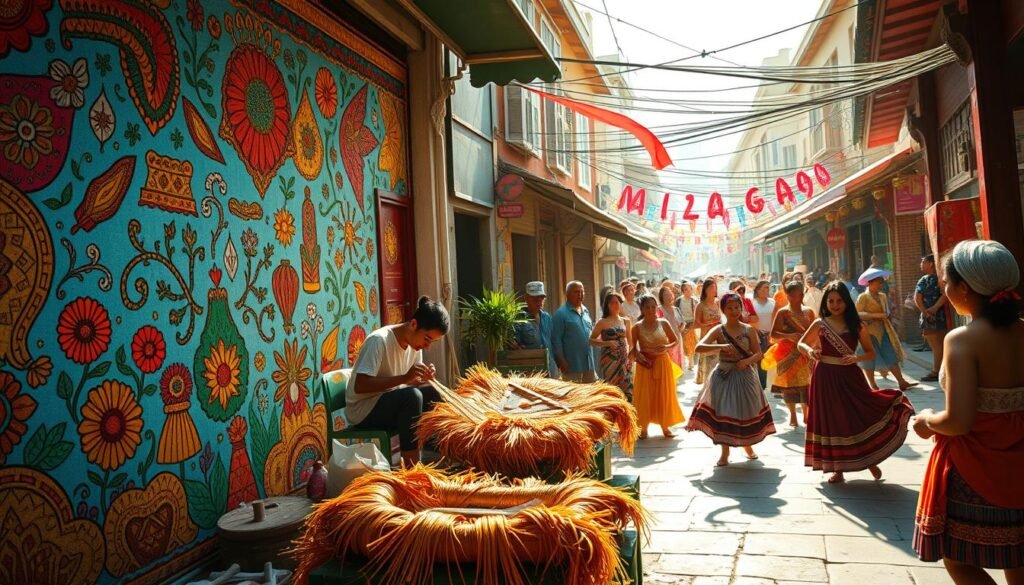
Artistic techniques and mediums have evolved over time, becoming symbols of national heritage. Filipino creators have used materials like wood, pigments, and textiles to craft works that tell stories of resilience and identity. These practices not only preserve cultural traditions but also inspire future generations.
Artistic Techniques and Mediums Explored
Filipino artists have mastered various techniques to convey their cultural narratives. From intricate wood carvings to vibrant paintings, each medium carries a unique purpose. For example, the use of natural dyes in textiles reflects a deep connection to the environment, while sculptures often depict historical figures and events.
One notable artist, Fernando Amorsolo, is celebrated for his mastery of light and shadow in paintings. His works capture the essence of rural life, evoking a sense of nostalgia and pride. Similarly, Guillermo Tolentino’s sculptures immortalize national heroes, reminding Filipinos of their shared history.
“Art is not just about aesthetics; it’s about preserving the soul of a nation.”
The design and structure of these works often carry hidden meanings. Symbols like the sun, stars, and waves are recurring motifs, representing hope, freedom, and unity. These elements highlight the ingenuity of Filipino creators in expressing complex ideas through simple forms.
Art also plays a vital role in fostering community pride. Public murals and installations bring people together, creating spaces for dialogue and reflection. As highlighted in this insightful article, art serves as a catalyst for social change, challenging stereotypes and promoting empathy.
- Art preserves cultural heritage by conveying customs and stories.
- Techniques like wood carving and painting reflect local traditions.
- Prominent artists like Amorsolo and Tolentino redefine cultural expression.
- Design elements like symbols and motifs carry deeper meanings.
- Public art fosters community pride and social cohesion.
In times of adversity, art becomes a powerful tool for resistance and resilience. Filipino creators have used their works to challenge oppression and assert their identity. This enduring legacy underscores the importance of art in shaping cultural identity and fostering a sense of purpose among individuals and communities.
Influences of Japanese Aesthetics on Filipino Work
The Japanese aesthetic principles left a profound mark on Filipino creative expression during the occupation. This period saw a unique blend of styles, where traditional Filipino techniques merged with Japanese minimalism and symbolism. The result was a new wave of work that reflected both cultural resilience and adaptation.
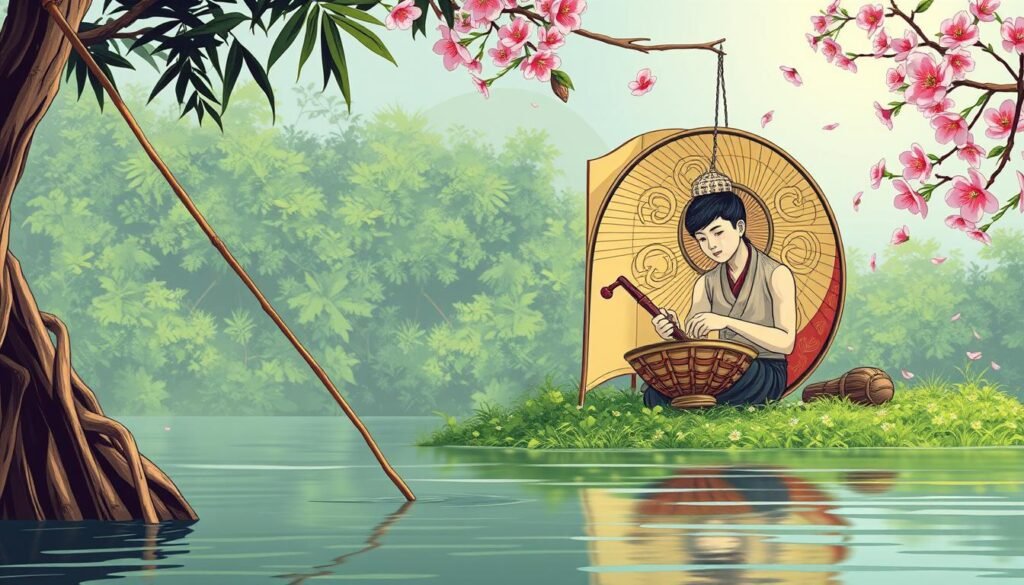
Visual Arts Innovations Under Censorship
Japanese aesthetics subtly influenced Filipino visual arts during censorship. Artists incorporated elements like asymmetry and naturalism, hallmarks of Japanese design, into their painting and architecture. These techniques allowed them to convey deeper meanings while adhering to strict guidelines.
One notable example is the integration of impressionism into local works. Filipino creators adopted the loose brushstrokes and focus on light, inspired by Japanese prints. This approach provided a new means of expression, enabling artists to depict everyday life with emotional depth.
Islamic art also played a role in this cross-cultural exchange. Geometric patterns and calligraphic elements, common in Islamic design, were reinterpreted in Filipino works. These motifs added layers of meaning, often symbolizing unity and resistance.
The reinterpretation of objects and mediums was another significant development. Everyday items like pottery and textiles became canvases for artistic innovation. For instance, Japanese pottery techniques were adapted to create functional yet aesthetically pleasing objects, blending utility with beauty.
This historical evolution highlights how external influences enriched Filipino creativity. The fusion of Japanese and Islamic aesthetics provided new avenues for artistic expression, shaping the history of Filipino visual arts.
| Influence | Impact on Filipino Work |
|---|---|
| Japanese Minimalism | Introduced asymmetry and naturalism in painting and architecture. |
| Impressionism | Inspired loose brushstrokes and focus on light in local works. |
| Islamic Art | Reinterpreted geometric patterns and calligraphy in Filipino designs. |
| Pottery Techniques | Blended Japanese methods with local craftsmanship. |
These cross-cultural exchanges not only transformed Filipino visual arts but also reinforced their role in preserving cultural identity. For more on this vibrant cultural exchange, explore the influence of Japanese aesthetics on Filipino creativity.
Artistic Figures and Movements During Censorship
The Japanese occupation era brought both challenges and opportunities for Filipino creators, shaping their artistic narratives in profound ways. Despite strict censorship, many artists found innovative ways to express their cultural identity and resist oppression. This section highlights notable figures and movements that defined this period.
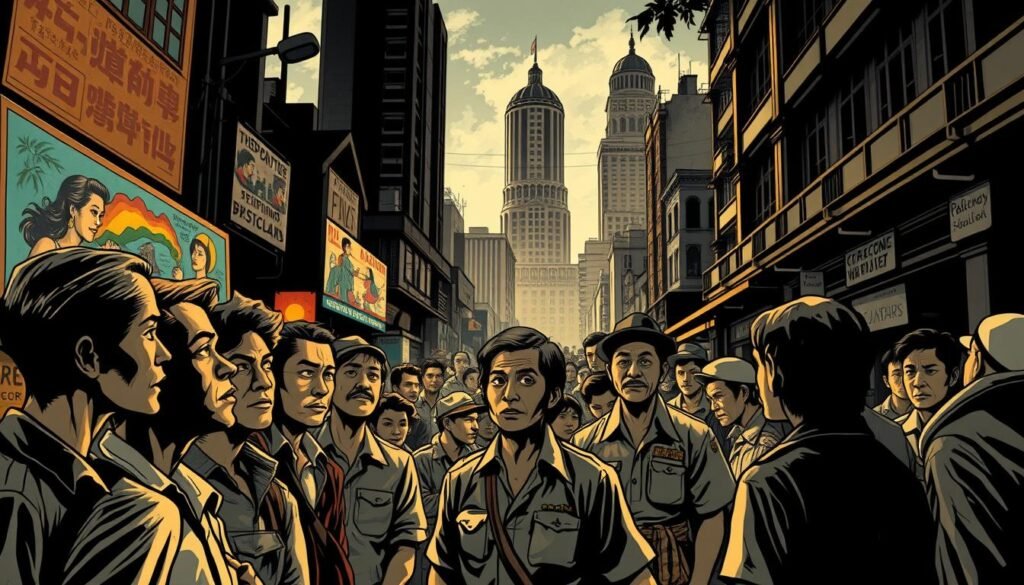
Notable Filipino Artists and Their Contributions
Filipino artists like Fernando Amorsolo and Carlos “Botong” Francisco played pivotal roles during this time. Amorsolo’s mastery of light and shadow captured the resilience of rural life, while Francisco’s murals depicted historical events with emotional depth. Their works became symbols of hope and resistance.
Another influential artist, Victorio Edades, challenged traditional norms by introducing modernist techniques. His bold approach inspired a generation of creators to experiment with new forms of expression. These individuals not only preserved Filipino culture but also redefined the concept of work art under censorship.
Key Artistic Movements and Their Legacies
The period saw the emergence of movements that blended local traditions with global influences. Impressionism, for instance, inspired Filipino creators to focus on light and emotion, resulting in works that subtly conveyed deeper meanings. This style allowed artists to evade censorship while maintaining their creative integrity.
Islamic art also left its mark, with geometric patterns and calligraphic elements appearing in Filipino designs. These motifs symbolized unity and resistance, reflecting the adaptability of Filipino creators. The fusion of these styles enriched the nation’s artistic heritage, leaving a lasting legacy.
“Censorship forced us to think outside the box. Every stroke, every pattern, carried a hidden message.”
Figures like Marcel Duchamp, though not directly involved, influenced Filipino artists to explore unconventional methods. Their ability to adapt and innovate under such conditions highlights the enduring power of artistic expression. For more on the importance of preserving creative freedom, explore the NAEA Position Statement on Censorship and the.
- Amorsolo and Francisco used their works to reflect resilience and identity.
- Edades introduced modernist techniques, inspiring future generations.
- Impressionism and Islamic art influenced Filipino artistic movements.
- Artists adapted their methods to convey hidden messages under censorship.
- This period shaped the evolution of Filipino creative expression.
Comparing Japanese and Filipino Artistic Ideals
The interplay between Japanese and Filipino artistic ideals reveals fascinating contrasts in expression and technique. While both cultures value creativity, their approaches to work art and cultural identity differ significantly. This section explores these differences, focusing on their impact on artistic practice and design.
Contrasts in Expression and Technique
Japanese artistic ideals often emphasize minimalism and naturalism. This is evident in their use of asymmetry and subtle symbolism in architecture and pottery. Filipino creators, on the other hand, tend to incorporate vibrant colors and intricate patterns, reflecting their rich cultural heritage.
For example, Japanese work art frequently focuses on the concept of wabi-sabi, which finds beauty in imperfection. Filipino artists, however, often prioritize storytelling and emotional depth, embedding hidden messages in their work to reflect resilience and identity.
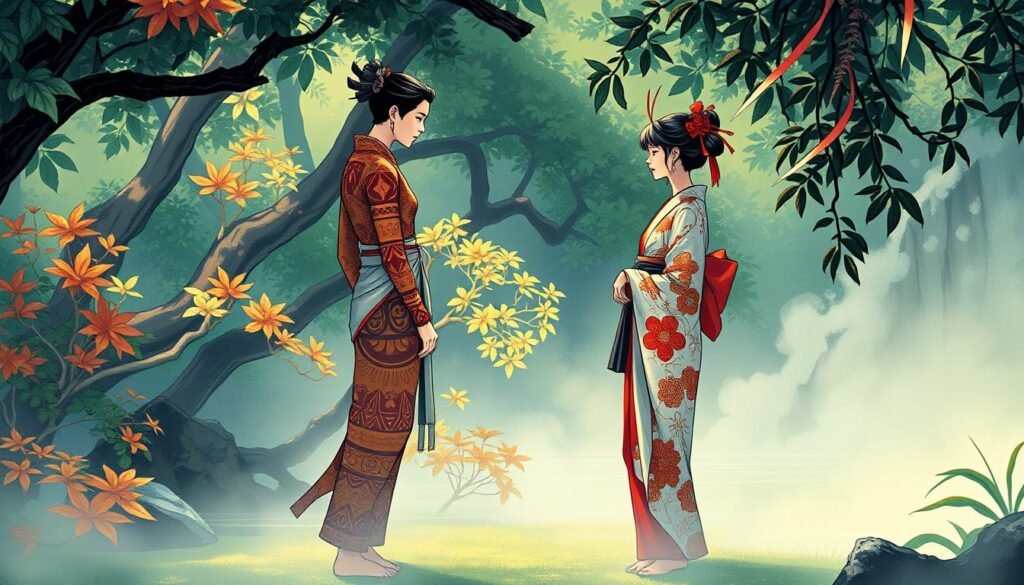
Role of Mediums in Artistic Expression
Both cultures use diverse mediums to convey their artistic values. In Japan, pottery and architecture are central to their creative expression. The chanoyu (tea ceremony) pottery, for instance, embodies simplicity and functionality.
In the Philippines, performance and visual arts play a significant role. Traditional dances and folk songs often carry coded messages of resistance, while paintings and sculptures reflect the nation’s history and struggles.
“The differences in artistic expression between Japan and the Philippines highlight the unique ways cultures interpret creativity and identity.”
Quantitative Reflections and Historical Context
Over the century, both cultures have evolved in their artistic practice. In the 20th century, Japanese influence on Filipino work art became more pronounced, particularly during the occupation. This period saw a blending of styles, with Filipino artists adopting Japanese techniques while maintaining their distinct identity.
For more on the influence of Japanese aesthetics on Filipino creativity, explore the Filipino affinity for Japanese design.
| Aspect | Japanese Artistic Ideals | Filipino Artistic Ideals |
|---|---|---|
| Focus | Minimalism, naturalism | Storytelling, emotional depth |
| Mediums | Pottery, architecture | Performance, visual arts |
| Technique | Asymmetry, subtle symbolism | Vibrant colors, intricate patterns |
| Historical Influence | 20th-century blending of styles | Resilience and identity |
This comparative analysis underscores the richness of both Japanese and Filipino artistic traditions. Their unique approaches to creativity and design continue to inspire and influence global work art.
Conclusion
The evolution of Filipino creativity under Japanese censorship reveals a story of resilience and adaptability. Despite strict controls, artists found innovative ways to express their identity. They used painting, performance, and other mediums to embed hidden messages, turning their work into a silent rebellion.
Key terms like content and purpose highlight how Filipino creators navigated censorship. Their ability to adapt shows the duality of art—both as a product and a dynamic means of expression. This period left a lasting impact on society, shaping the cultural landscape of the Philippines.
Art captured the spirit of life during challenging times, serving as a tool for cultural and social resilience. It also preserved traditions and inspired future generations. For more on how art reflects cultural identity, explore the development of lacquer sculptures in East.
FAQ
What influenced Filipino artistic expression during Japanese censorship?
Filipino artistic expression during Japanese censorship was shaped by a blend of pre-colonial traditions, colonial influences, and the restrictions imposed by Japanese policies. Artists adapted their work to navigate these limitations while preserving cultural identity.
How did Japanese censorship policies affect Filipino visual arts?
Japanese censorship policies restricted themes and subjects in Filipino visual arts, leading artists to innovate with symbolism and subtle messaging. This period saw a transformation in styles and techniques to comply with governmental guidelines.
Who were notable Filipino artists during the Japanese occupation?
Notable Filipino artists during the Japanese occupation include Fernando Amorsolo and Vicente Manansala. Their work reflected resilience and adaptation, blending traditional Filipino themes with the constraints of the era.
What role did performing arts play under Japanese censorship?
Performing arts became a vital medium for cultural expression under Japanese censorship. Artists used theater, music, and dance to subtly convey resistance and maintain Filipino identity despite strict regulations.
How did Japanese aesthetics influence Filipino art during this period?
Japanese aesthetics introduced new techniques and perspectives to Filipino art. Artists incorporated elements like minimalism and nature-inspired themes, creating a unique fusion of styles that reflected both cultures.
What were the key artistic movements during Japanese censorship in the Philippines?
Key artistic movements during this period included the rise of modernist approaches and the use of allegory in visual arts. These movements allowed artists to express dissent and cultural pride indirectly.
How did Filipino art contribute to cultural identity during Japanese occupation?
Filipino art played a crucial role in preserving and asserting cultural identity during the Japanese occupation. Through creative adaptation, artists kept traditional practices alive while addressing contemporary challenges.
What were the main contrasts between Japanese and Filipino artistic ideals?
Japanese artistic ideals often emphasized simplicity and harmony, while Filipino art focused on vibrant storytelling and community themes. These contrasts highlighted the cultural differences between the two nations.
Source Links
- Guns, Art, and Empathy: How Filipinos Opposed the
Japanese Occupation (1942â•fi1945) - CCP Encyclopedia of Philippine Art | CCP Encylopedia of Philippine Art
- From Ephemeral Experiences to Lasting Legacies: Discourses on Experimental Art in the Philippines during the 1960s and 1970s – Tate Papers | Tate
- How the Spaniards Shaped Filipino Culture
- Arts in the Philippines
- History of Philippine Arts from Pre-Colonial to Present
- Contemporary Arts in the Philippines: An Introduction
- Japanese Representation in Philippine Media
- Second Philippine Republic / The Axis Powers | The Second World War
- Propaganda in Japan during the Second Sino-Japanese War and World War II
- Art and the Power of Freedom of Expression | Contemporary Art Gallery in LA Mash Gallery
- Art Censorship
- Art Terminology – a glossary — ModernArts
- The Significance of Art in Revealing a Culture’s Identity and Multiculturalism
- Art and Cultural Identity: Exploring the Intersections
- Cultural Identity in Art: Unveiling Impact and Connections
- Japanese in the Philippines
- Picturing the Philippines
- Provenance Art Gallery at Finopinas: Painting Filipino-Japanese Connections in Tokyo – Bridges Magazine
- The Impact of War on Art: How Conflict Shapes Creativity and Culture
- ‘The House Is Still Burning’: Censorship, Pandemic and Art in the Philippines
- Art Censorship: First Amendment Violation or Private Free Speech?
- Christmas in Japan vs. Christmas in the Philippines: A Cultural Comparison
- The Development of Art Galleries in the Philippines – National Commission for Culture and the Arts
- The Art of the Conclusion | Pomona College in Claremont, California – Pomona College
- The Influence of Art on History, Part 4: Conclusion – Traveling Thru History

